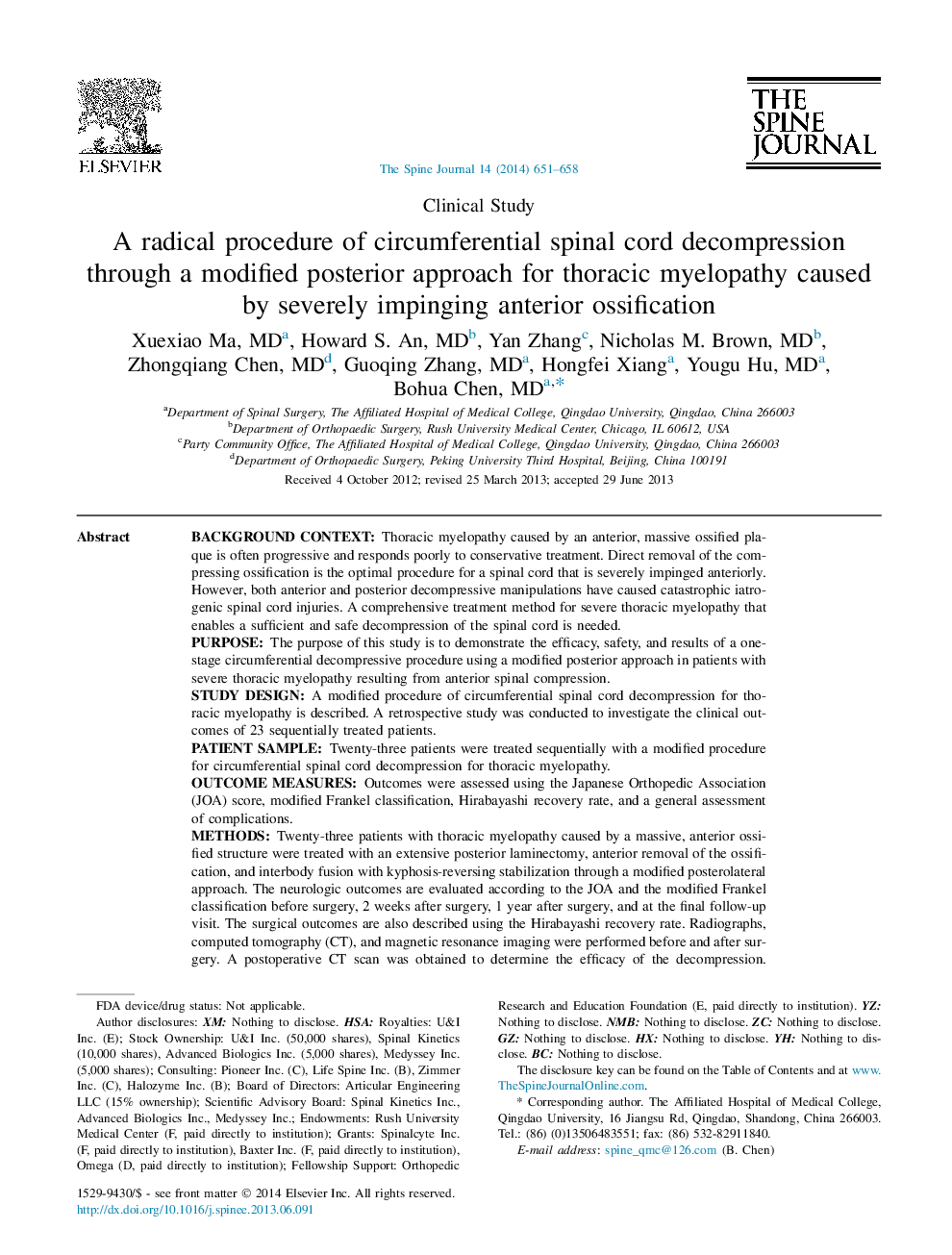| کد مقاله | کد نشریه | سال انتشار | مقاله انگلیسی | نسخه تمام متن |
|---|---|---|---|---|
| 4097023 | 1268578 | 2014 | 8 صفحه PDF | دانلود رایگان |
Background contextThoracic myelopathy caused by an anterior, massive ossified plaque is often progressive and responds poorly to conservative treatment. Direct removal of the compressing ossification is the optimal procedure for a spinal cord that is severely impinged anteriorly. However, both anterior and posterior decompressive manipulations have caused catastrophic iatrogenic spinal cord injuries. A comprehensive treatment method for severe thoracic myelopathy that enables a sufficient and safe decompression of the spinal cord is needed.PurposeThe purpose of this study is to demonstrate the efficacy, safety, and results of a one-stage circumferential decompressive procedure using a modified posterior approach in patients with severe thoracic myelopathy resulting from anterior spinal compression.Study designA modified procedure of circumferential spinal cord decompression for thoracic myelopathy is described. A retrospective study was conducted to investigate the clinical outcomes of 23 sequentially treated patients.Patient sampleTwenty-three patients were treated sequentially with a modified procedure for circumferential spinal cord decompression for thoracic myelopathy.Outcome measuresOutcomes were assessed using the Japanese Orthopedic Association (JOA) score, modified Frankel classification, Hirabayashi recovery rate, and a general assessment of complications.MethodsTwenty-three patients with thoracic myelopathy caused by a massive, anterior ossified structure were treated with an extensive posterior laminectomy, anterior removal of the ossification, and interbody fusion with kyphosis-reversing stabilization through a modified posterolateral approach. The neurologic outcomes are evaluated according to the JOA and the modified Frankel classification before surgery, 2 weeks after surgery, 1 year after surgery, and at the final follow-up visit. The surgical outcomes are also described using the Hirabayashi recovery rate. Radiographs, computed tomography (CT), and magnetic resonance imaging were performed before and after surgery. A postoperative CT scan was obtained to determine the efficacy of the decompression. Operative time, intraoperative blood loss, and complications were reviewed from the medical records. In addition, a 48-year-old man who presented with severe thoracic myelopathy resulting from anterior impingement with multiple osteophytes is described as an illustrative patient.ResultsThe sites of ossification in this series were distributed widely, from T4–T12. The anterior ossified plaques of all patients were resected completely. Five patients who had intraoperative evidence of dural ossification required resection of the ossified dura matter. The average operating time was 276 minutes. Mean intraoperative blood loss was 1,350 mL. The postoperative follow-up ranged from 2.5 to 6 years, with an average of 4.6 years. The average preoperative JOA score was 4.3±1.5 points, and it improved to 6.1±1.9 points 2 weeks postoperatively, to 8.1±1.8 points 1 year postoperatively, and to 8.5±1.9 points at the most recent follow-up. The overall Hirabayashi recovery rate at the final examination averaged 63.6±22.4%. Eight patients were graded as excellent, 10 as good, 4 as fair, and 1 as unchanged. No patient was graded as deteriorated. The paralysis improved by at least 1 grade in 22 patients (95.7%). Transient deterioration of thoracic myelopathy occurred immediately after surgery in three patients (13%). Cerebrospinal fluid leakage occurred in six patients (26.1%). One patient sustained severe bilateral groin pain, three had unilateral intercostal neuralgia, and pleura tear occurred in one patient.ConclusionOne-stage posterior decompression, anterior extirpation of the ossification, and interbody fusion with instrumentation via a modified posterior approach is a safe and effective treatment for severe thoracic myelopathy resulting from prominent anterior impingement. This procedure is technically demanding, and the indications are limited to thoracic myelopathy caused by severe anterior impingement of various etiologies from T4–T12.
Journal: The Spine Journal - Volume 14, Issue 4, 1 April 2014, Pages 651–658
